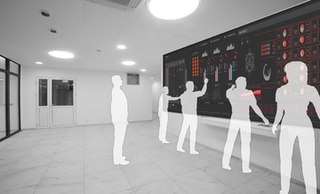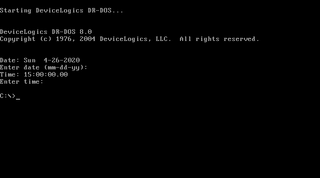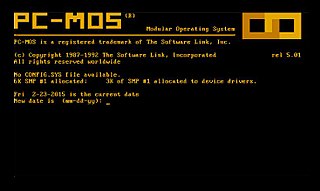Related Research Articles

Multi-user software is computer software that allows access by multiple users of a computer. Time-sharing systems are multi-user systems. Most batch processing systems for mainframe computers may also be considered "multi-user", to avoid leaving the CPU idle while it waits for I/O operations to complete. However, the term "multitasking" is more common in this context.

DR-DOS is an operating system of the DOS family, written for IBM PC-compatible personal computers. It was originally developed by Gary A. Kildall's Digital Research and derived from Concurrent PC DOS 6.0, which was an advanced successor of CP/M-86. As ownership changed, various later versions were produced with names including Novell DOS and Caldera OpenDOS.

Digital Research, Inc. was a company created by Gary Kildall to market and develop his CP/M operating system and related 8-bit, 16-bit and 32-bit systems like MP/M, Concurrent DOS, FlexOS, Multiuser DOS, DOS Plus, DR DOS and GEM. It was the first large software company in the microcomputer world. Digital Research was originally based in Pacific Grove, California, later in Monterey, California.
In computing, the DOS Protected Mode Interface (DPMI) is a specification introduced in 1989 which allows a DOS program to run in protected mode, giving access to many features of the new PC processors of the time not available in real mode. It was initially developed by Microsoft for Windows 3.0, although Microsoft later turned control of the specification over to an industry committee with open membership. Almost all modern DOS extenders are based on DPMI and allow DOS programs to address all memory available in the PC and to run in protected mode.
Virtual DOS machines (VDM) refer to a technology that allows running 16-bit/32-bit DOS and 16-bit Windows programs when there is already another operating system running and controlling the hardware.

Multiuser DOS is a real-time multi-user multi-tasking operating system for IBM PC-compatible microcomputers.
A DOS extender is a computer software program running under DOS that enables software to run in a protected mode environment even though the host operating system is only capable of operating in real mode.
Phar Lap was a software company specializing in software development tools for DOS operating systems. The company was named after the champion Australian racehorse Phar Lap. They were most noted for their software allowing developers to access memory beyond the 640 KiB limit of DOS and were an author of the VCPI standard.

PC-MOS/386 is a multi-user, multitasking computer operating system produced by The Software Link (TSL), announced at COMDEX in November 1986 for February 1987 release. PC-MOS/386, a successor to PC-MOS, can run many MS-DOS programs on the host machine or a terminal connected to it. Unlike MS-DOS, PC-MOS/386 is optimized for the Intel 80386 processor; however early versions will run on any x86 computer. PC-MOS/386 used to be proprietary, but it was released as open-source software in 2017.
A self-booting disk is a floppy disk for home or personal computers that loads directly into a standalone application when the system is turned on, bypassing the operating system. This was common, even standard on some computers, in the late 1970s to early 1990s. Video games were the type of application most commonly distributed using this technique.

Alloy Computer Products is an Australian manufacturer of information technology products based near Melbourne. As of 2007, the company currently markets networking and VoIP products. The company was originally based in Framingham, Massachusetts and by 1990 was part of the Fortune 500. At one point Alloy was a major producer of QIC format tape drives and other computer peripherals. In the mid 1990s the company was no longer profitable. It filed for bankruptcy in the U.S. and the Australian subsidiary was bought out by the management team from the Australian division.
The DOS API is an API which originated with 86-DOS and is used in MS-DOS/PC DOS and other DOS-compatible operating systems. Most calls to the DOS API are invoked using software interrupt 21h. By calling INT 21h with a subfunction number in the AH processor register and other parameters in other registers, various DOS services can be invoked. These include handling keyboard input, video output, disk file access, program execution, memory allocation, and various other activities. In the late 1980s, DOS extenders along with the DOS Protected Mode Interface (DPMI) allow the programs to run in either 16-bit or 32-bit protected mode and still have access to the DOS API.
FlexOS is a discontinued modular real-time multiuser multitasking operating system (RTOS) designed for computer-integrated manufacturing, laboratory, retail and financial markets. Developed by Digital Research's Flexible Automation Business Unit in Monterey, California, in 1985, the system was considered to become a successor of Digital Research's earlier Concurrent DOS, but with a new, modular, and considerably different system architecture and portability across various processor families. Still named Concurrent DOS 68K and Concurrent DOS 286, it was renamed into FlexOS on 1 October 1986 to better differentiate the target audiences. FlexOS was licensed by several OEMs who selected it as the basis for their own operating systems like 4680 OS, 4690 OS, S5-DOS/MT and others. Unrelated to FlexOS, the original Concurrent DOS system architecture found a continuation in successors like Concurrent DOS XM and Concurrent DOS 386 as well.
In computing, the Virtual Control Program Interface (VCPI) is a specification published in 1989 by Phar Lap Software that allows a DOS program to run in protected mode, granting access to many features of the processor not available in real mode. It was supplanted by DOS Protected Mode Interface (DPMI) shortly after being introduced, due in large part to VCPI's inability to work in Windows 3.0's protected mode.
This article presents a timeline of events in the history of 16-bit x86 DOS-family disk operating systems from 1980 to 2020. Non-x86 operating systems named "DOS" are not part of the scope of this timeline.
The ICL DRS was a range of departmental computers from International Computers Limited (ICL). Standing originally for Distributed Resource System, the full name was later dropped in favour of the abbreviation.
VM/386 is a multitasking operating system or 'control program' that took early advantage of the capabilities of Intel's 386 processor. By utilizing Virtual 8086 mode, users were able to run their existing text-based and graphical DOS software in safely separate environments. The system offered a high degree of control, with the ability to set memory limits, CPU usage and scheduling parameters, device assignments, and interrupt priorities through a virtual machine manager menu. Unique CONFIG.SYS and AUTOEXEC.BAT files could be configured for each application, and even different DOS versions. In 1991 the vendor announced intentions to support DPMI 1.0 in VM/386.
MS-DOS 4.0 was a multitasking release of MS-DOS developed by Microsoft based on MS-DOS 2.0. Lack of interest from OEMs, particularly IBM, led to it being released only in a scaled-back form. It is sometimes referred to as European MS-DOS 4.0, as it was primarily used there. It should not be confused with PC DOS 4.00 or MS-DOS 4.01 and later, which did not contain the multi-tasking features.
References
- 1 2 3 "NetWorld 90 - NetWorld: Multi-Vendor Answers". Communications News. Nelson Publishing / Gale, Cengage Learning. 1990-11-01. Archived from the original on 2018-08-20. Retrieved 2014-09-10.
- 1 2 3 Barker, Dennis, ed. (November 1990). "Share or LAN?". Microbytes: Nanobytes. BYTE . Vol. 15 no. 12. McGraw-Hill, Inc. pp. 19–20, 24, 28, 32 [32]. ISSN 0360-5280 . Retrieved 2021-12-09. p. 32:
The Multiuser DOS Federation is promoting multiuser PCs as an alternative to LANs. One MDOS member says it's "a myth" that LANs are the only way for groups of computer users to work together. The organization hopes to establish standards for multiuser computing. Among the charter members are representatives of Digital Research, Theos Software, SunRiver, DigiBoard, Alloy, and Viewport International.
- ↑ Wurthmann, Gerold; Wopperer, Bernhard; Wiesböck, Johann (1991). "Die DPMI-Spezifikation – Eine Einführung – Appendix B: DPMI Hosts" [An introduction to the DPMI specification – appendix B: DPMI hosts]. Vorträge und Begleittexte zum 2. Entwicklerforum der Design & Elektronik zum Thema: PC-Architektur, 17. September 1991, München[Presentations and supplemental material for the second developer forum on PC architecture on 17 September 1991, Munich] (book) (in German) (1 ed.). Munich, Germany: Markt & Technik Verlag Aktiengesellschaft. pp. 223, 239. (NB. The forum was organized by the German magazine Design & Elektronik and Intel.)